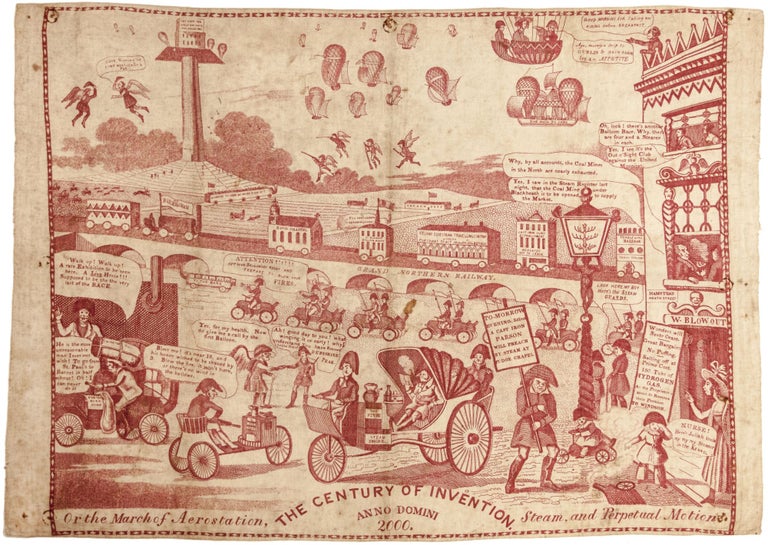
“The Century of Invention. Anno Domini 2000. Or the March of Aerostation, Steam and Perpetual Motion.”.
Lithograph printed in red on linen as a handkerchief. (image 15 x 19 1/2 in., (38.0 x 49.5 cm.); sheet 15 1/8 x 21 1/2 (38.4 x 54.8 cm). Some minor spotting. Margins show evidence of thumbtacks used for display. Locomotives and experimental steam engine carriages were both in use by the 1830s. The cartoonist, unaware that the internal combustion engine and the automobile would be invented later that century, lampoons the steam carriage rather than the increasingly reliable train. Only buildings on wheels traverse his “Grand Northern Railway” bridge. One of these, the “Steamo Equestrian Travelling Company,” involves no actual horses. Neither does the stag hunt by steam-carriage above the bridge. A crier below advertises a “rare Exhibition” of outmoded transportation: “A Live Horse!!! Supposed to be the very last of the RACE.” Even religion has been ameliorated by technology. As the “Zion Chappel” rolls by, a man advertises tomorrow’s sermon: “A CAST IRON PARSON WILL PREACH BY STEAM AT FUDGE CHAPEL.” The hubris of these futuristic inventors is clearest in the sky. Balloon travel was no longer considered viable when this print appeared, yet its Londoners float over to Dublin and back before breakfast. A balloon race is also taking place (between the “Out o’Sight Club” and the “United Moonites”). Like the mythical Icarus, who flew too close to the sun, the flying men hunting a flock of birds will probably bring about their own ruin by inadvertently shooting the balloons. This lithograph was sold as a printed handkerchief, a relatively common form of ephemera during the late eighteenth and nineteenth centuries, but one which rarely survives. As no publishing information appears on the print, it may well have been a pirated edition. The image is an enlarged, reversed copy of a lithograph by caricaturist C.J. Grant from the Every Body’s Album & Caricature Magazine no. 3, February 1, 1834. He contributed regularly to the magazine, which appeared in thirty-nine sheets every two weeks from 1834-35. Grant also produced numerous separately-issued lithographs in paper formats, but not of the present image. The artist’s considerable body of work has been unjustly overlooked until recently; e.g. his Thieme Becker entry notes only that he cut a single wood engraving for the popular London periodical “Punch.” The satirist’s biting wit still shines through today as he gains a proper reception: “Everybody’s album contains some of Grant's finest lithographic work, as well as displaying his imagination at its most fertile". (R.J. Pound, ed., C.J. Grant's political drama: a radical satirist rediscovered, 1998, p 10.)
Extremely rare, separately-issued caricature printed on linen satirizing the early nineteenth-century British love affair with transportation. The print imagines the consequences of technological progress in the year 2000. It depicts a wild fantasy overrun with improbable vehicles from the impracticable and obsolete to the quixotic: steam-powered carriages, giant hydrogen balloons, and men sprouting wings. The handkerchief was also offered in sepia (McCormick Collection of Aeronautica, Item 284, no. 60, Princeton University). Fortunately, perhaps, the survival-rate of handkerchiefs is low, and the McCormick impression is the only other copy located.
Sold
